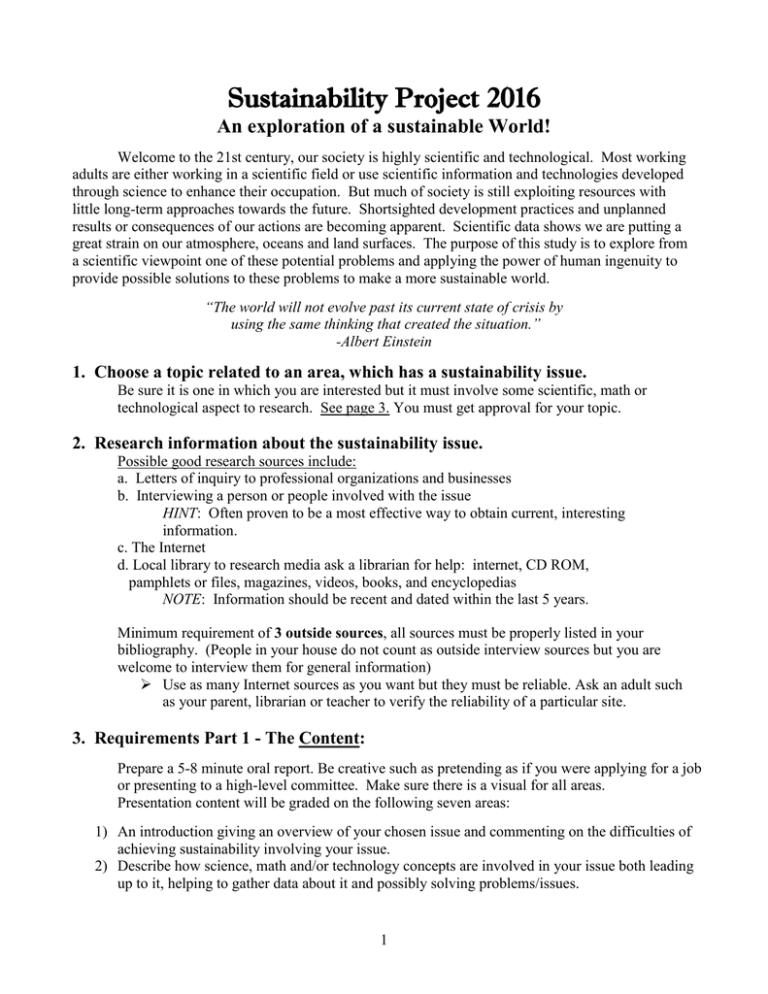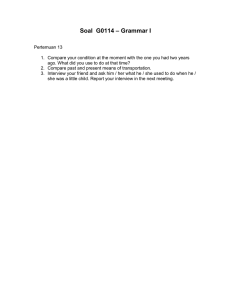Sustainability Project 2016 An exploration of a sustainable World!
advertisement

Sustainability Project 2016 An exploration of a sustainable World! Welcome to the 21st century, our society is highly scientific and technological. Most working adults are either working in a scientific field or use scientific information and technologies developed through science to enhance their occupation. But much of society is still exploiting resources with little long-term approaches towards the future. Shortsighted development practices and unplanned results or consequences of our actions are becoming apparent. Scientific data shows we are putting a great strain on our atmosphere, oceans and land surfaces. The purpose of this study is to explore from a scientific viewpoint one of these potential problems and applying the power of human ingenuity to provide possible solutions to these problems to make a more sustainable world. “The world will not evolve past its current state of crisis by using the same thinking that created the situation.” -Albert Einstein 1. Choose a topic related to an area, which has a sustainability issue. Be sure it is one in which you are interested but it must involve some scientific, math or technological aspect to research. See page 3. You must get approval for your topic. 2. Research information about the sustainability issue. Possible good research sources include: a. Letters of inquiry to professional organizations and businesses b. Interviewing a person or people involved with the issue HINT: Often proven to be a most effective way to obtain current, interesting information. c. The Internet d. Local library to research media ask a librarian for help: internet, CD ROM, pamphlets or files, magazines, videos, books, and encyclopedias NOTE: Information should be recent and dated within the last 5 years. Minimum requirement of 3 outside sources, all sources must be properly listed in your bibliography. (People in your house do not count as outside interview sources but you are welcome to interview them for general information) Use as many Internet sources as you want but they must be reliable. Ask an adult such as your parent, librarian or teacher to verify the reliability of a particular site. 3. Requirements Part 1 - The Content: Prepare a 5-8 minute oral report. Be creative such as pretending as if you were applying for a job or presenting to a high-level committee. Make sure there is a visual for all areas. Presentation content will be graded on the following seven areas: 1) An introduction giving an overview of your chosen issue and commenting on the difficulties of achieving sustainability involving your issue. 2) Describe how science, math and/or technology concepts are involved in your issue both leading up to it, helping to gather data about it and possibly solving problems/issues. 1 3) Discuss in detail various possible practical solutions in regards to your issue. Practical means a solution that could be implemented within the foreseeable future. 4) Discuss some of the difficulties in implementing your suggested solutions discussed in area #3. 5) Discuss which solution you personally recommend and why you recommend it. To support your position include a possible outcome or outcomes if your solution is not adopted. 6) What do you consider the actual prospects in the future for your solutions, which solution is likely to be adopted or if none of them then what is the most likely course of action that you think will take place and why do you think it might happen? 7) Include a conclusion that summarizes your project. Consider mentioning your interview (not required) if interesting. 4. Requirements Part 2 - The Visuals and Presentation: Presentation Grade will be also evaluated on the visual effort/quality of workmanship and the qualities such as: 1. Enthusiasm, make it into an exciting presentation, first impressions are important, so work on your enthusiasm, voice and eye contact with the audience. 2. Effective organization of the presentation, the flow of ideas and the detail/quality of the information. 3. Speaking clearly with effective emphasis (no pure reading), with few pauses and fidgeting (movement without a purpose). 4. Note sheets or cards are clear, neat and include appropriately detailed bibliographical information and student name 5. Show visuals that capture some of the excitement, problems and/or possibilities of your sustainability issue. 6. Visuals are of high quality, are detailed and show excellent effort, quality of workmanship and creativity. 7. Well thought out arguments for particular positions or ideas and practical solutions. 8. Special effects: such as a display, pictures, diagrams or charts, role-playing, "tools" of the trade, etc. 5. Remember to turn in the following at the appropriate time: Turn in Note Sheets or Cards clearly marked with each area 1-7 and include separate bibliography (make as many sheets/cards as needed) A letter requesting an interview may be stamped or turned in at some point Interview questions in preparation before the interview Your score sheets and rubric critiquing other projects Presentation including visuals and clear information A bibliography sheet or cards 6. Practice, Practice and more Practice This can be accomplished by talking to your-self in front of a mirror, in the shower, or other quiet times. Try recording your presentation so you can hear yourself and also present it to someone else: a friend, parent or other relative. 2 Sustainability Project Possibilities Plastics use, waste Solid waste management Reusing tires and other car parts Minimalistic or reusable packaging Paper recycling and reduction of use Computer equipment waste Recycling buildings Water Household gray-water systems Industrial water usage Groundwater over usage vs. recharge Water reduction of use systems Business water usage Golf courses Drinking water and pollution Plastic water bottles Land Farmland preservation Soil Preservation Home and Business Buildings Building site selection and orientation Lighting, industrial, home etc Building materials/construction Heating/Cooling (Insulation) Landscape impacts Air quality Appliances Sustainable Grazing Sustainable Mining Sustainable farming Wetland/Marshland preservation Sustainable Forestry/Lumber Desertification reduction Oceans Transportation Over-fishing Non-point source pollution Mineral extraction Oil extraction Coral reefs Fish farms Automobile (Compare to gas) biodiesel, hybrid, fuel cell, solar, electric Train-long distance: Passenger, maglev Airline (construction components, fuel) Freight: Train, Truck, And Ship Energy Food Production (also see Land and Ocean) Home reduction, alternatives Business reduction, alternatives Solar divide into types Large scale Electrical, Home electrical, water heating systems Wind divide into types Large commercial, small scale/home Biomass divide into types Biofuels, Wood and Wood waste, Landfill gas and garbage Non-transportation Fuel Cell Fossil Fuels divide into types Coal, Oil, Diesel, Natural Gas Nuclear Fusion, Fission Tidal electrical Geothermal Hydroelectric large scale Hog farms large vs. small scale Chicken Farms large vs. small Organic versus non-organic Radiated vs. other food preservation techniques Effect on Soil of different crops Integrated Pest Management vs Spray Soil Conservation and tilling Irrigation systems and efficiency Many other possibilities, but they must be approved Waste Management 3

